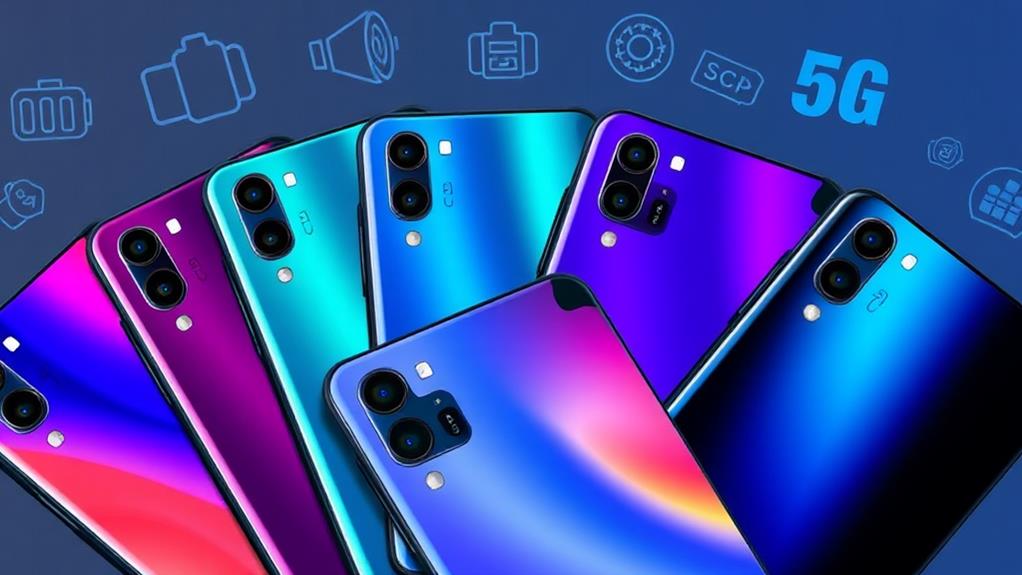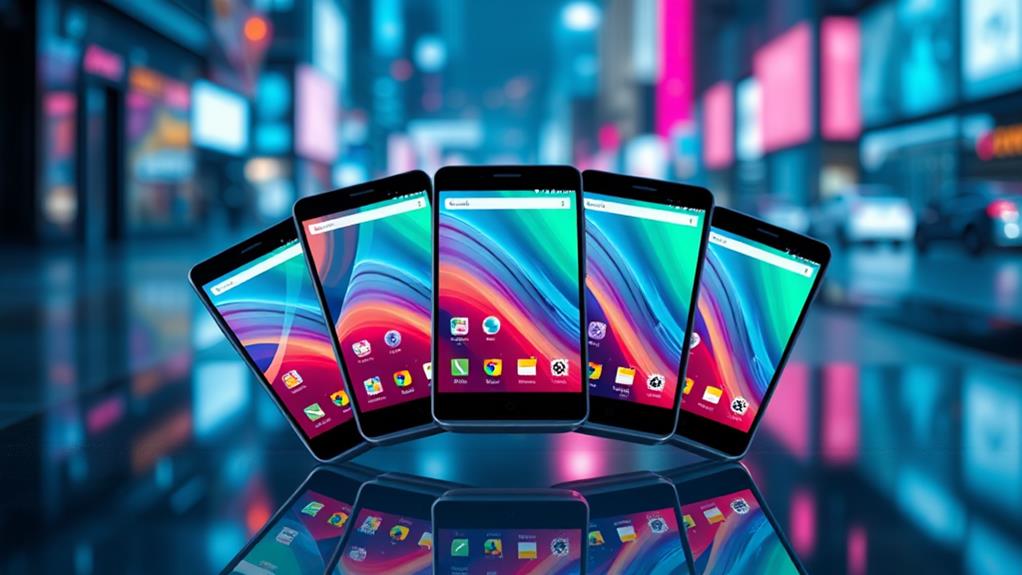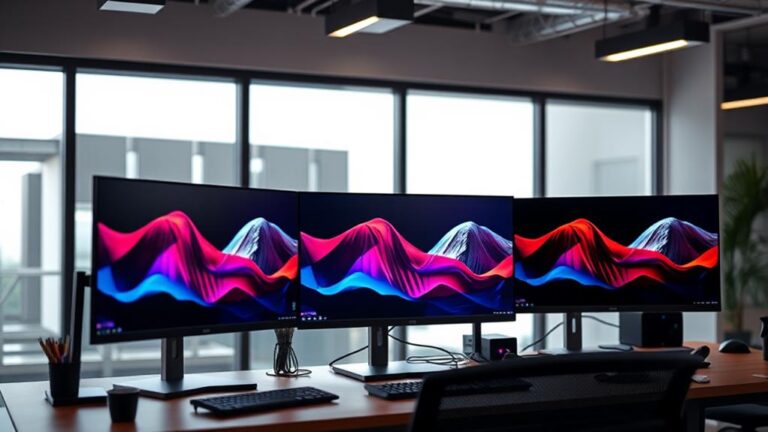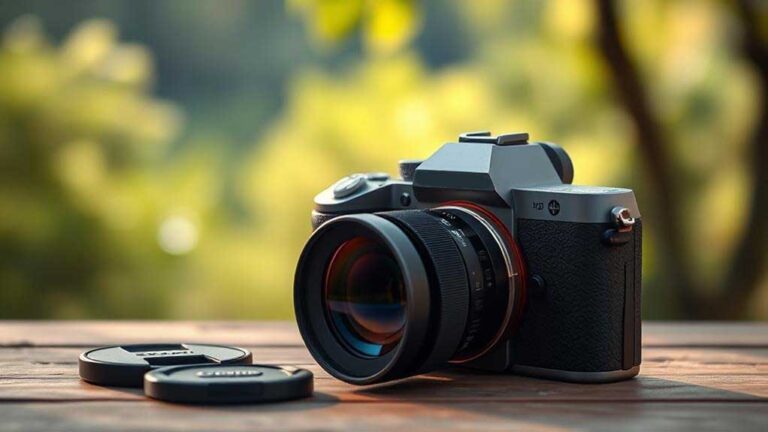Links below are affiliate links. We earn a commission on purchases at no extra cost to you. Although our opinions are based on curated research, we have not used these products. Article generated with AI.
In 2025, Android smartphones offer cutting-edge technology in compact packages. The Samsung Galaxy A35 5G boasts a powerful Exynos 1380 chipset and a vibrant 120Hz AMOLED display. Google’s Pixel 8 features the advanced Tensor G3 chip for enhanced AI capabilities.
The Samsung Galaxy A15 provides a long-lasting 5000 mAh battery and impressive camera setup. The Google Pixel 7a excels in low-light photography with its 64MP rear camera. Motorola’s Moto G54 5G combines a smooth 120Hz refresh rate with ample storage.
When choosing, consider factors like display quality, battery life, camera capabilities, and processor performance. Further exploration will reveal more about these top contenders and their innovative features.
Highlights
- Samsung Galaxy A35 5G offers a 120Hz AMOLED display, 5000 mAh battery, and a triple-lens camera system with a 50 MP main camera.
- Google Pixel 8 features an AI-powered Tensor G3 chip, exceptional camera quality, and up to 72 hours of battery life with Extreme Battery Saver.
- Samsung Galaxy A15 boasts a 6.5-inch Super AMOLED display, 5000 mAh battery, and expandable storage up to 1TB.
- Google Pixel 7a excels with a 64MP rear camera, 24-hour battery life, and advanced security features including biometric authentication.
- Motorola Moto G54 5G offers a 120Hz refresh rate display, 256GB storage, and a 50MP main camera with Optical Image Stabilization.
SAMSUNG Galaxy A35 5G Smartphone
SAMSUNG Galaxy A35 5G Smartphone
Discover the Galaxy A35 5G, designed for effortless searching, stunning photography, and endless storage. With water resistance and a digital wallet, it’s ready for any adventure you take.
For budget-conscious consumers seeking a feature-packed smartphone, the SAMSUNG Galaxy A35 5G stands out as a top contender in 2025. This device offers a compelling blend of performance and value, with its 5nm Exynos 1380 chipset and 6GB of RAM guaranteeing smooth operation for everyday tasks. The 5000 mAh battery, coupled with 25W fast charging, provides ample power for extended use.
Photography enthusiasts will appreciate the versatile triple-lens camera system, which includes a 50 MP main camera with optical image stabilization for sharp, blur-free images. The phone’s 120Hz AMOLED display, featuring Vision Booster technology, delivers vibrant visuals in various lighting conditions. With its IP67 rating for water and dust resistance, the Galaxy A35 5G is built to withstand daily challenges. Samsung’s commitment to long-term software support, offering four Android upgrades and five years of security patches, guarantees the device remains current and secure.
Best For: Budget-conscious consumers seeking a feature-rich, durable smartphone with excellent camera capabilities and long-term software support.
Pros:
- Versatile triple-lens camera system with 50 MP main camera and optical image stabilization
- Large 5000 mAh battery with 25W fast charging for extended use
- IP67 water and dust resistance, coupled with durable Victus Glass design
Cons:
- The plastic frame may feel less premium compared to all-glass or metal designs
- Some users report the phone being slippery when placed glass-side down
- 128GB base storage may be limiting for power users, requiring additional MicroSD card purchase
Google Pixel 8 Android Smartphone
Google Pixel 8 Unlocked Android Smartphone
Meet Pixel 8, your smart companion from Google. With a stunning camera, robust security, and all-day battery, it harnesses AI to enhance your life with quick answers and safety features.
Tech enthusiasts seeking cutting-edge AI features and exceptional camera capabilities will find the Google Pixel 8 a standout choice. This liberated Android smartphone boasts a 6.2-inch Actua display with a 120Hz refresh rate, ensuring smooth scrolling and responsive gaming. The device’s 128 GB storage and 8 GB RAM, coupled with the Google Tensor G3 chip, deliver robust performance for daily tasks and AI-powered functions.
You’ll appreciate the Pixel 8’s advanced camera system, which offers vivid colors, striking details, and Macro Focus for close-up shots. The 4575 mAh battery provides over 24 hours of use, extendable to 72 hours with Extreme Battery Saver. Security features include a VPN by Google One and the Titan M2 chip, while personal safety tools like crash detection add peace of mind. Despite some mixed reviews on default settings, users generally praise the Pixel 8’s overall performance and user experience.
Best For: Tech-savvy users who prioritize advanced AI features, superior camera quality, and a seamless Android experience in a compact smartphone.
Pros:
- Exceptional camera system with AI-enhanced features and Macro Focus
- Powerful performance with Google Tensor G3 chip and 8GB RAM
- Long-lasting battery life with Extreme Battery Saver option
Cons:
- Mixed reviews on default settings and app organization
- Concerns about warranty services (Asurion)
- Frequent software updates may disrupt user preferences
Samsung Galaxy A15 Smartphone
Samsung Galaxy A15 Smartphone (A155M)
Experience vibrant clarity on the Galaxy A15’s 6.5-inch Super AMOLED display. Capture stunning photos with a 50MP camera while enjoying powerful performance and lasting battery life.
Budget-conscious smartphone users seeking a blend of performance and affordability will find the Samsung Galaxy A15 (A155M) an attractive option. This device boasts a 6.5-inch Super AMOLED display with 1080 x 2340 pixel resolution and a 90Hz refresh rate, ensuring smooth scrolling and vibrant visuals. The phone’s 5000 mAh battery can last up to two days, addressing concerns about frequent charging.
With 128GB of storage, 6GB of RAM, and MicroSD support up to 1TB, you’ll have ample space for apps and media. The triple rear camera setup, featuring a 50MP main sensor with optical image stabilization, allows for versatile photography. While not ideal for gaming or demanding applications, the Mediatek Helio G99 octa-core processor performs well for everyday tasks like browsing, emailing, and messaging. The Galaxy A15 offers good value for users who prioritize basic smartphone functionality without breaking the bank.
Best For: Budget-conscious consumers seeking a reliable smartphone with good battery life and decent performance for everyday tasks.
Pros:
- Long-lasting 5000 mAh battery provides up to two days of use
- Vibrant 6.5-inch Super AMOLED display with 90Hz refresh rate
- Expandable storage up to 1TB with MicroSD support
Cons:
- Not suitable for gaming or high-demand applications
- Charging speed may be slower compared to higher-end models
- Some users report concerns about overall system performance
Google Pixel 7a Android Smartphone
Google Pixel 7a Unlocked Android Smartphone (128 GB)
Meet the Pixel 7a! Powered by the Google Tensor G2 chip, it offers lightning-fast performance, amazing camera features, and all-day battery life—plus online security with Google VPN—all at an affordable price.
Photography enthusiasts will find the Google Pixel 7a a compelling choice among 2025‘s best Android smartphones. This device boasts a 64MP rear camera with advanced low-light capabilities and photo editing features. The 6.1-inch OLED display and 1080p video capture guarantee a high-quality visual experience. Powered by the Google Tensor G2 chip, the Pixel 7a offers fast performance and enhanced security.
Battery life is impressive, with up to 24 hours of use per charge and an Extreme Battery Saver mode extending that to 72 hours. The phone includes biometric security features like fingerprint and face recognition, though some users report inconsistencies. While the camera system receives praise, it’s significant to highlight that it may have limitations compared to professional cameras. Overall, the Pixel 7a presents a strong value proposition in the mid-range smartphone market, despite some reported issues with network compatibility and customer support.
Best For: Photography enthusiasts and Android users seeking a mid-range smartphone with excellent camera capabilities, long battery life, and strong overall performance.
Pros:
- Advanced 64MP rear camera with low-light capabilities and photo editing features
- Impressive battery life with up to 24 hours of use and Extreme Battery Saver mode
- Powered by Google Tensor G2 chip for fast performance and enhanced security
Cons:
- Some users report inconsistencies with fingerprint recognition
- Camera may have limitations compared to professional cameras
- Potential issues with network compatibility and varying customer support experiences
Motorola Moto G54 5G Smartphone
Motorola Moto G54 5G Smartphone (International Version)
Experience entertainment like never before with the Moto g54 5G. Enjoy stunning visuals, immersive sound, and long-lasting battery life—all wrapped in a sleek, water-resistant design.
For those seeking a feature-packed Android experience without breaking the bank, the Motorola Moto G54 5G stands out as a compelling option. This international version boasts a 6.5-inch IPS LCD display with a smooth 120Hz refresh rate, ensuring crisp visuals for your daily tasks and entertainment. You’ll find ample storage with 256GB ROM and 8GB RAM, expandable via microSDXC if needed.
The Moto G54 5G’s camera system is impressive, featuring a 50MP main sensor with Optical Image Stabilization for steady shots. Its Mediatek Dimensity 7020 processor handles demanding apps with ease, while 5G connectivity keeps you future-proofed. However, it is crucial to mention that this open device is compatible only with GSM networks, not CDMA. The water-resistant design offers peace of mind against everyday spills, complementing its ergonomic build and convenient side-mounted fingerprint scanner.
Best For: Budget-conscious smartphone users seeking a feature-rich 5G device with excellent camera capabilities and ample storage.
Pros:
- High-resolution 50MP camera with OIS for impressive photo quality
- Large 256GB storage with 8GB RAM for smooth multitasking
- 5G connectivity and water-resistant design for future-proofing and durability
Cons:
- Limited compatibility with U.S. carriers (GSM networks only, no CDMA)
- Some users report weaker cell reception compared to other models
- Potential issues with SMS delivery on certain networks
Factors to Consider When Choosing Android Smartphones

When choosing an Android smartphone, you’ll need to weigh several key factors to find the best device for your needs. Consider the display size and quality, as these affect your viewing experience, alongside battery life and charging capabilities, which determine how long you can use your phone between charges. Additionally, evaluate the camera capabilities, processor performance, and storage options, as these features impact your phone’s functionality and ability to handle various tasks.
Display Size and Quality
The display of your Android smartphone serves as the window into all your digital interactions. When choosing a device, you’ll want to take into account both size and quality. Display sizes typically range from 5.0 to over 7.0 inches, measured diagonally. Larger screens can enhance your experience for gaming, browsing, and watching videos, but they may also impact the phone’s portability.
High-quality displays often use AMOLED or OLED technology, which provides deeper blacks and more vibrant colors compared to traditional LCD screens. You’ll also want to look at the refresh rate, measured in Hertz (Hz). Higher rates, like 90Hz or 120Hz, offer smoother scrolling and improved responsiveness, especially beneficial for gaming.
Brightness, measured in nits, is essential for outdoor visibility. Look for displays capable of reaching 1000 nits or more for ideal use in bright sunlight. Resolution is another key factor, with Full HD (1080 x 2400 pixels) being a common standard. Higher resolutions enhance detail and clarity in images and videos, but they can also impact battery life. Reflect on these factors to find a display that best suits your needs and usage patterns.
Battery Life and Charging
While a stunning display enhances your smartphone experience, it’s the battery that keeps you connected throughout the day. When choosing an Android smartphone, you’ll want to take into account battery capacity, which typically ranges from 4000mAh to 5000mAh in modern devices. This capacity can provide anywhere from 24 to 48 hours of usage, depending on your habits and the phone’s efficiency.
Fast charging technology is another vital factor to examine. Many smartphones now support charging speeds of 25W or more, greatly reducing the time you’ll spend tethered to an outlet. You should also look for features like Extreme Battery Saver modes, which can extend your phone’s life up to 72 hours by limiting background activities.
Don’t overlook the importance of processor efficiency and software optimization, as these elements heavily impact overall battery performance. Adaptive battery management, a feature that learns your usage patterns to optimize power consumption, can be particularly beneficial. By evaluating these factors, you’ll be better equipped to choose an Android smartphone that meets your battery life needs and keeps you powered throughout your day.
Camera Capabilities and Features
Shutterbugs and casual photographers alike will find camera capabilities to be an essential factor when selecting their next Android smartphone. When evaluating camera systems, you’ll want to pay attention to several key features. Resolution, measured in megapixels (MP), plays a critical role in image quality. Higher MP counts, such as 50MP or 64MP, offer superior detail and perform better in low-light conditions. Optical Image Stabilization (OIS) is another important feature, helping to reduce blur from slight hand movements during photo or video capture.
Many top Android phones now boast multiple rear cameras, typically including wide, ultrawide, and macro lenses. This versatility allows you to capture a range of scenes, from sweeping landscapes to intricate close-ups. Advanced features like macro focus enable detailed close-up photography, expanding your creative possibilities. Additionally, software enhancements powered by artificial intelligence (AI) can considerably improve your photos through automated editing and image processing. These AI-driven tools make it easier for you to achieve professional-looking results without extensive manual editing. When choosing your next Android smartphone, consider how these camera capabilities align with your photography needs and preferences.
Processor Performance and Speed
Processor powerhouses are at the heart of every Android smartphone, dictating its overall performance and capabilities. When evaluating a device’s processing prowess, you’ll want to take into account several key factors. First, look at the chip’s architecture and fabrication process. The latest 5nm chips offer superior speed and efficiency compared to older 7nm or 10nm designs. Next, examine the core configuration. Octa-core processors, with their mix of high-performance and power-efficient cores, excel at multitasking and handling demanding apps. Clock speed, measured in GHz, is another essential metric. Higher speeds generally translate to quicker processing times, though it’s not the only determinant of performance. Don’t overlook the integrated GPU, which plays a fundamental role in gaming and media experiences by enhancing graphics rendering. To get a thorough view of a processor’s capabilities, check out benchmark scores from reputable sources like Geekbench or AnTuTu. These scores can provide valuable insights into real-world performance expectations. By reflecting on these aspects, you’ll be better equipped to choose an Android smartphone that meets your performance needs in 2024.
Storage Capacity Options
Storage capacity often gets overlooked when choosing a new Android smartphone, but it can make or break your user experience. When evaluating your options, you’ll typically find models starting at 64GB and ranging up to 512GB or more. Many Android devices also support expandable storage through MicroSD cards, potentially adding up to 1TB of extra space.
Your choice should reflect your usage patterns. If you’re a casual user, 128GB might suffice for your needs. However, if you’re a power user or avid gamer, you’ll likely benefit from 256GB or higher to accommodate larger apps and extensive media libraries. It’s vital to factor in the operating system’s storage management capabilities, as newer Android versions often offer more efficient caching and data handling.
Don’t forget to take into account cloud storage integration, a feature many smartphones now offer. This can alleviate storage concerns by providing online options for your photos, videos, and documents. Ultimately, selecting the right storage capacity guarantees you won’t constantly struggle with low space warnings, allowing you to fully enjoy your device’s capabilities without limitations.
5G Connectivity Support
As you explore the latest Android smartphones, 5G connectivity should be a key consideration. This advanced technology offers notably faster data transfer rates compared to 4G LTE networks, enabling quicker downloads and uploads. When evaluating 5G-capable devices, it’s crucial to understand that they often utilize advanced technologies like sub-6 GHz and mmWave frequencies to enhance connectivity in various environments.
Before purchasing a 5G smartphone, check its compatibility with your service provider, as 5G network availability varies by carrier and region. The benefits of 5G become apparent in high-demand applications such as streaming high-definition video, online gaming, and video conferencing, where you’ll experience improved performance.
As 5G technology continues to evolve, it’s becoming increasingly standard in new smartphone models. Many devices now offer dual SIM options, supporting both 4G and 5G networks to guarantee versatility. When choosing your next Android smartphone, consider how 5G connectivity aligns with your usage habits and location. While 5G offers exciting possibilities, it’s vital to weigh its advantages against other factors like battery life, cost, and overall device performance to make an informed decision.
Design and Durability
When choosing your next Android smartphone, design and durability should be at the forefront of your considerations. Look for devices with an IP67 or higher rating, which guarantees protection against water and dust intrusion. This rating safeguards your phone from accidental spills and environmental hazards, extending its lifespan.
Pay attention to the materials used in construction. Smartphones featuring Victus Glass or Gorilla Glass offer superior resistance to scratches and drops compared to standard glass. These robust materials can save you from costly repairs or replacements. Additionally, evaluate the phone’s ergonomic design. A comfortable grip reduces the likelihood of accidental drops and enhances overall usability during daily activities.
Consider smartphones with integrated fingerprint scanners in the power button. This feature adds convenience and security without compromising the device’s aesthetics. Finally, assess the weight and dimensions of the phone. A device that fits comfortably in your hand and pocket is essential for prolonged use and portability. Remember, a heavier model may become cumbersome over time, affecting your user experience. By prioritizing these design and durability factors, you’ll guarantee your new Android smartphone meets your needs for both form and function.
Software Updates and Security
Longevity in the digital age hinges on software updates and security features. When choosing an Android smartphone, you’ll want to take into account the manufacturer’s track record for providing timely updates and long-term support. Many brands now offer up to four major Android upgrades and five years of security patches, which is vital for maintaining your device’s performance and protecting your data.
Regular security updates address vulnerabilities that could be exploited by malware, making them indispensable for safeguarding your personal information. The frequency and duration of these updates vary between manufacturers, so it’s important to research their support policies. Devices with advanced security features, such as biometric authentication (like fingerprint sensors or facial recognition) and integrated security chips, provide additional layers of protection against unauthorized access and data breaches.
To guarantee peak performance and security throughout your smartphone’s lifespan, prioritize devices from manufacturers known for their commitment to timely updates and robust support. By choosing a device with a strong update policy and advanced security features, you’ll be better equipped to protect your digital life in an ever-evolving technological landscape.
Frequently Asked Questions
How Does Android Compare to iOS in Terms of Security?
When comparing Android to iOS security, you’ll find both have strengths and weaknesses. Android offers more customization, but this can lead to increased vulnerability. iOS’s closed ecosystem provides better control over app security. Both systems use encryption and regular updates to protect your data. Android’s open-source nature allows for quicker identification of vulnerabilities, while iOS’s strict app review process helps prevent malware. Ultimately, your security depends on how you use your device and keep it updated.
Can I Use My Android Smartphone as a Mobile Hotspot?
Ever wondered about the hidden potential of your Android device? You can indeed use your Android smartphone as a mobile hotspot. This feature, also known as tethering, allows you to share your phone’s cellular data connection with other devices. To activate it, go to your phone’s settings, look for “Hotspot & Tethering,” and turn on “Mobile Hotspot.” Set a network name and password, and you’re ready to connect other devices to your phone’s internet connection.
What’s the Average Lifespan of an Android Smartphone?
The average lifespan of an Android smartphone is typically 2-3 years, but it can vary depending on several factors. You’ll find that hardware durability, software updates, and your usage habits play significant roles. High-end devices often last longer due to better build quality and extended software support. However, battery degradation, which affects all smartphones, can reduce performance over time. While your phone may continue to function beyond this period, you might experience slower speeds and compatibility issues with newer apps.
Are There Any Privacy Concerns Specific to Android Devices?
Android devices do raise some privacy concerns you should be aware of. Google collects extensive data on your usage habits, which can feel intrusive. Third-party apps may access more of your personal information than you’d like. Pre-installed bloatware can’t always be removed, potentially compromising your privacy. Android’s open-source nature, while beneficial in many ways, can also make it more vulnerable to malware. However, you can mitigate these risks by adjusting your privacy settings and being cautious about app permissions.
How Often Do Android Smartphones Receive Operating System Updates?
Like a well-oiled machine, Android smartphones receive updates at varying frequencies. You’ll find that flagship devices from major manufacturers often get monthly security patches and two to three years of major OS updates. However, mid-range and budget phones may receive updates less frequently, sometimes quarterly or bi-annually. The update schedule depends on factors like the device’s age, manufacturer’s policies, and hardware capabilities. It’s worth noting that Google’s Pixel phones typically receive updates first and most consistently.








